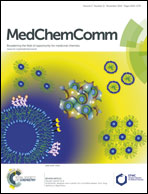Novel anti-HIV-1 NNRTIs based on a pyrazolo[4,3-d]isoxazole backbone scaffold: design, synthesis and insights into the molecular basis of action†
Abstract
A series of novel pyrazolo[4,3-d]isoxazoles was synthesized employing the thioamide synthon 3 to obtain the phenyldiazenylthiazolyl derivatives 7a–f, the thiazolyl derivative 9, the carbohydrazonamide 12 and the triazinyl counterparts 14a–c. The prepared compounds were screened for their antiviral activities against two viral strains of HIV-1 (RF and IIIB). All the compounds exhibited a highly potent antiviral capacity, having submicromolar to subnanomolar EC50 values with all derivatives being more active against the tested HIV strains than the reference drug efavirenz. The therapeutic index of these novel pyrazoloisoxazoles was also evaluated against the host cells CEM-SS or MT-4 and they exhibited a high therapeutic window. To further investigate the molecular basis of their actions, the inhibitory ability of these compounds was bioscreened against the HIV-1 viral enzyme reverse transcriptase (RT). The observed very potent inhibitory power of the pyrazolo[4,3-d]isoxazoles against RT prompted a molecular docking study to try exploring the potential binding modes of these compounds with their respective molecular targets. Finally, in vitro exploration of the metabolic stability of this series of compounds was evaluated by employing a rat-plasma half-life assay and they demonstrated reasonable hydrolytic resistance.
![Graphical abstract: Novel anti-HIV-1 NNRTIs based on a pyrazolo[4,3-d]isoxazole backbone scaffold: design, synthesis and insights into the molecular basis of action](/en/Image/Get?imageInfo.ImageType=GA&imageInfo.ImageIdentifier.ManuscriptID=C4MD00282B&imageInfo.ImageIdentifier.Year=2014)

 Please wait while we load your content...
Please wait while we load your content...